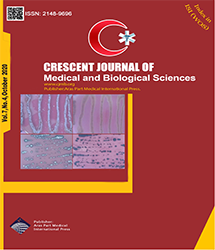| Original Article | |
| Pathogenesis Traits and Antimicrobial Resistance Pattern in Escherichia coli Isolates Recovered From Sewage | |
| Behnaz Naraghi1, Mojtaba Afsharnia1, Jalal Mardaneh2, Mojtaba Kianmehr3, Hamed Biglari1, Javad Bazeli4, Mojtaba Anvarinejad5 | |
| 1Department of Environmental Health Engineering, School of Public Health, Social Development and Health Promotion Research Center, Gonabad University of Medical Sciences, Gonabad, Iran 2Department of Microbiology, School of Medicine, and Infectious Diseases Research Center, Gonabad University of Medical Sciences, Gonabad, Iran 3Department of Medical Physics, Faculty of Medicine, Gonabad University of Medical Sciences, Gonabad, Iran 4Nursing Department, Nursing and Midwifery, Gonabad University of Medical Sciences, Gonabad, Iran 5Professor Alborzi Clinical Microbiology Research Center, Nemazee Hospital, Shiraz University of Medical Sciences, Shiraz, Iran |
|
|
CJMB 2020; 7: 488-496 Viewed : 4081 times Downloaded : 6803 times. Keywords : Escherichia coli, Sewage, Virulence, Antimicrobial resistance |
|
| Full Text(PDF) | Related Articles | |
| Abstract | |
Objectives: Escherichia coli is one of the most potential agents of community and hospital-acquired infections, which can readily acquire non-susceptibility to drugs administered to animals and humans. E. coli, which has been broadly applied as an indicator of fecal contamination in aquatic environments, is routinely conducted non-virulence. Nevertheless, some isolates can be virulence. The main objectives of this work were to survey antibiotic non-susceptibility and to characterize virulence factors and antibiotic resistance genes including traT, fimH, blaCTX, and tetA among the E. coli isolates recovered from sewage in Gonabad, in the northeast of Iran. Materials and Methods: In this cross-sectional study, a total of 99 non-duplicate strains of E. coli was removed from three types of sewage including poultry (33 isolates), urban (33), and livestock slaughterhouse (33) sewages in Gonabad from May 2016 to April 2017. Then, the antimicrobial susceptibility test and extended-spectrum-beta-lactamase (ESBL) production were done based on CLSI guidelines, followed by performing the polymerase chain reaction technique to identify 2 virulence (traT and fimH) and 2 antibiotic resistance (blaCTX and tetA) genes. Results: Meropenem was the most effective drug against the strains. The analysis of multiple drug non-susceptibility profiles in the strains showed that 39 (39.3%) strains were TR-NAR and three (3.03%) of them were resistant to colistin. Totally, 21 (21.2%) strains were ESBL-positive and 15 (71.42%) ESBL+ isolates carried blaCTX gene whereas 87.9% and 100% of the strains in the livestock slaughterhouse and urban sewages carried the tetA gene, respectively. Finally, 85.7% of ESBL-positive isolates carried the fimH gene. Overall, 19.8% of ESBL-positive strains carried fimH and traT virulence genes (fimH+-traT+ genotype). Conclusions: Based on the findings of this study, wastewater and surface waters are considered as significant sources of E. coli carrying ESBL-genes, high levels of antibiotic non-susceptibility, and pathogenesis traits. Eventually, the identified colistin non-susceptible strains are quite worrying. |
Cite By, Google Scholar
Google Scholar
PubMed
Online Submission System
 CJMB ENDNOTE ® Style
CJMB ENDNOTE ® Style
 Tutorials
Tutorials
 Publication Charge
Medical and Biological Research Center
About Journal
Publication Charge
Medical and Biological Research Center
About Journal
Aras Part Medical International Press Editor-in-Chief
Arash Khaki
Deputy Editor
Zafer Akan


















